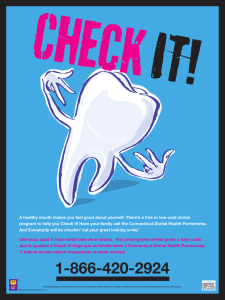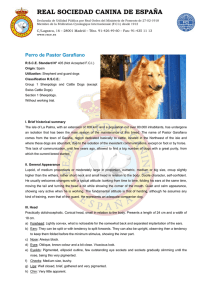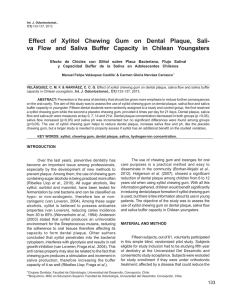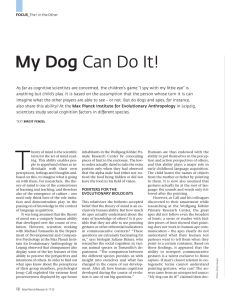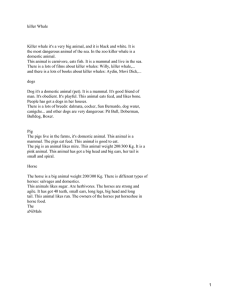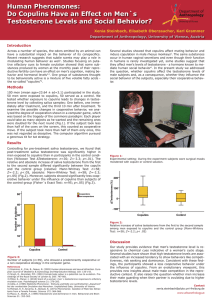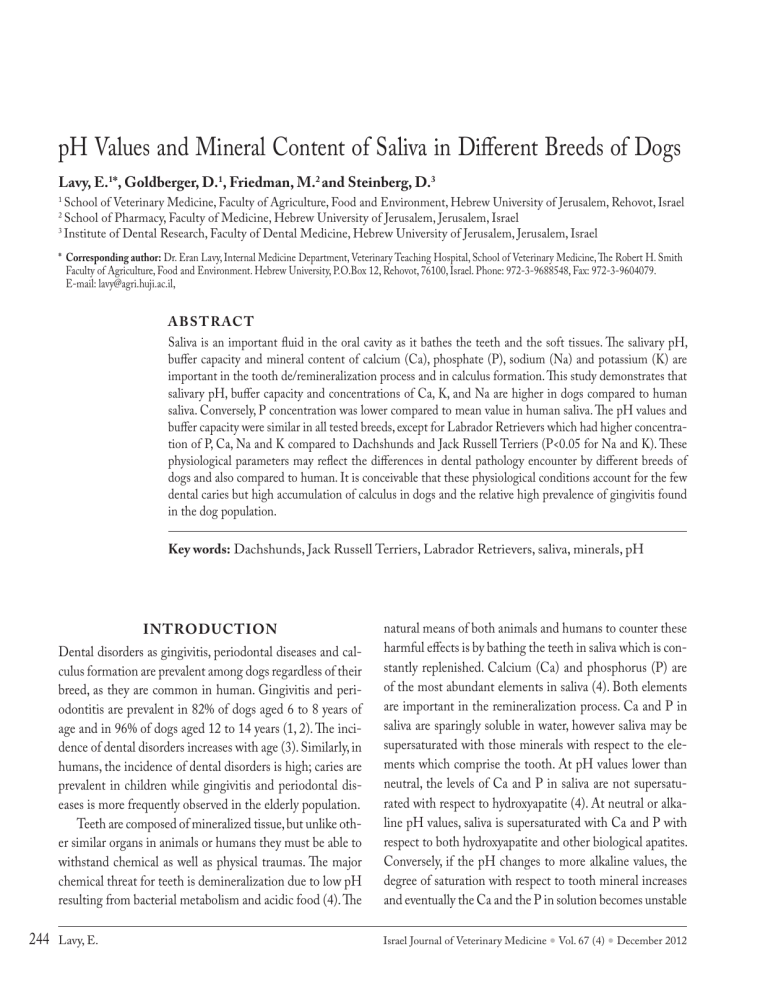
pH Values and Mineral Content of Saliva in Different Breeds of Dogs Lavy, E.1*, Goldberger, D.1, Friedman, M.2 and Steinberg, D.3 School of Veterinary Medicine, Faculty of Agriculture, Food and Environment, Hebrew University of Jerusalem, Rehovot, Israel School of Pharmacy, Faculty of Medicine, Hebrew University of Jerusalem, Jerusalem, Israel 3 Institute of Dental Research, Faculty of Dental Medicine, Hebrew University of Jerusalem, Jerusalem, Israel 1 2 * Corresponding author: Dr. Eran Lavy, Internal Medicine Department, Veterinary Teaching Hospital, School of Veterinary Medicine, The Robert H. Smith Faculty of Agriculture, Food and Environment. Hebrew University, P.O.Box 12, Rehovot, 76100, Israel. Phone: 972-3-9688548, Fax: 972-3-9604079. E-mail: [email protected], AB ST RAC T Saliva is an important fluid in the oral cavity as it bathes the teeth and the soft tissues. The salivary pH, buffer capacity and mineral content of calcium (Ca), phosphate (P), sodium (Na) and potassium (K) are important in the tooth de/remineralization process and in calculus formation. This study demonstrates that salivary pH, buffer capacity and concentrations of Ca, K, and Na are higher in dogs compared to human saliva. Conversely, P concentration was lower compared to mean value in human saliva. The pH values and buffer capacity were similar in all tested breeds, except for Labrador Retrievers which had higher concentration of P, Ca, Na and K compared to Dachshunds and Jack Russell Terriers (P<0.05 for Na and K). These physiological parameters may reflect the differences in dental pathology encounter by different breeds of dogs and also compared to human. It is conceivable that these physiological conditions account for the few dental caries but high accumulation of calculus in dogs and the relative high prevalence of gingivitis found in the dog population. Key words: Dachshunds, Jack Russell Terriers, Labrador Retrievers, saliva, minerals, pH Dental disorders as gingivitis, periodontal diseases and calculus formation are prevalent among dogs regardless of their breed, as they are common in human. Gingivitis and periodontitis are prevalent in 82% of dogs aged 6 to 8 years of age and in 96% of dogs aged 12 to 14 years (1, 2). The incidence of dental disorders increases with age (3). Similarly, in humans, the incidence of dental disorders is high; caries are prevalent in children while gingivitis and periodontal diseases is more frequently observed in the elderly population. Teeth are composed of mineralized tissue, but unlike other similar organs in animals or humans they must be able to withstand chemical as well as physical traumas. The major chemical threat for teeth is demineralization due to low pH resulting from bacterial metabolism and acidic food (4). The natural means of both animals and humans to counter these harmful effects is by bathing the teeth in saliva which is constantly replenished. Calcium (Ca) and phosphorus (P) are of the most abundant elements in saliva (4). Both elements are important in the remineralization process. Ca and P in saliva are sparingly soluble in water, however saliva may be supersaturated with those minerals with respect to the elements which comprise the tooth. At pH values lower than neutral, the levels of Ca and P in saliva are not supersaturated with respect to hydroxyapatite (4). At neutral or alkaline pH values, saliva is supersaturated with Ca and P with respect to both hydroxyapatite and other biological apatites. Conversely, if the pH changes to more alkaline values, the degree of saturation with respect to tooth mineral increases and eventually the Ca and the P in solution becomes unstable Lavy, E. Israel Journal of Veterinary Medicine Vol. 67 (4) December 2012 INTRODUCTION 244 Research Articles and precipitate, not necessarily as hydroxyapatite crystal but as the more readily formed mineral. Those sedimented minerals are the nucleates for calculus formation. The aim of this study was to examine the salivary pH, buffer capacity, Ca, P, Na, and K in different breeds of dogs, as they are pivotal physiological parameters of saliva, and to compare these to humans. MATERIALS AND METHODS Table 1- Calcium, phosphate, sodium, potassium mean concentration in dogs compared to the human known values. Mineral Calcium (mg/L) Phosphate (mg/L) Sodium (mg/L) Potassium (mg/L) Mean values of dogs SD 116.254 13.310 1644.029 1105.029 46.44 11.47 482.13 312.73 Human normal reference values (Edgar 1992) 20.04 – 108.2 58.845 - 390.22 46 – 483 391 - 1408 P* <0.05 <0.05 <0.05 <0.05 * One sample T-test. Dog population The tested dog population consisted of 37 dogs randomly selected from the dog breeding farm of Beit Erez and Beit Oved in Israel, as follows: 14 Dachshunds (2-6 years), 5 Jack Russell Terriers (2-6 years), 18 Labrador Retrievers (1-3 years). All dogs were healthy, ate commercial dry dog food and did not receive any medication or any special dental care for at least three months prior to the study. Dogs did not eat 12 hours prior to the salivary sampling but water was provided ad libitum. The study was approved by the Institutional Animal Care and Use Committee (IACUC) of the Agriculture Faculty of the Hebrew University of Jerusalem. pletely soaked with saliva. The rolls were immediately placed in test tubes. The saliva was extracted from the cotton role by centrifugation at 40C at 5000 RPM for 5 minutes as described by German et al. (5). The samples were then kept at -200C until further analyzed for mineral content. The concentrations of the minerals were normalized to 1 ml of saliva. Salivary pH and buffer capacity Salivary pH and buffer capacity were conducted by the use of pH indicator (Merck, Darmstadt, Germany) and commercial dental salivary buffer indicator (GC Corporation, Tokyo, Japan) immediately after collection of the saliva (6). Mineral content of saliva (Ca, P, Na and K): Saliva samples were taken from the dogs in the morning by the same examiner (D.G.) Ten human pediatric dental cotton rolls (Roeko-Luna, Langenau, Germany) were inserted into the oral cavity of the dogs and were held until com- The salivary samples were weighed and 2 ml of HNO3 (65%) was added to the samples. After 2 hours in boiling water the samples were cooled and double distilled water was added to make a final volume of 15 ml. The Ca, P, Sodium (Na) and Potassium (K) concentrations were measured using the ICPAES (Spectro, Kleve, Germany) techniques (7). The mineral Figure 1: Salivary pH of three different breeds of dogs Figure 2: Salivary buffer capacity of three different breeds of dogs Salivary sampling Israel Journal of Veterinary Medicine Vol. 67 (4) December 2012 pH and Mineral Content of Saliva of Dogs 245 Research Articles Figure 3: Salivary calcium levels of three different breeds of dogs Figure 4: Salivary phosphate levels of three different breeds of dogs Figure 5: Salivary potassium levels of three different breeds of dogs Figure 6: Salivary sodium levels of three different breeds of dogs analysis was conducted randomly on a group consisting of 20 dogs (8 Dachshunds, 5 Jack Russell Terriers and 7 Labrador Retrievers). The mean salivary pH value of dogs was 8.53 with a standard deviation of 0.34. There were no statistically signifi- cant differences among the three breeds tested (Figure 1). The buffer capacity of the saliva was statistically higher than those of humans (P<0.0001) and similar among the different tested breads of dogs (Figure 2). While the Dachshunds and the Jack Russell dogs had similar levels of Ca, the Labrador Retrievers showed 40% higher levels of Ca in their saliva (no statistically differences) (Figure 3). Similarly, the P levels of the Labrador Retrievers were also higher by 150% than the salivary P levels of Dachshunds and the Jack Russell Terriers (no statistically differences) (Figure 4). Salivary Na (Figure 5) and K concentrations (Figure 6) of Labrador Retrievers were also higher (P<0.05) than the two other breads (46% and 30%, respectively). Oral concentrations of calcium, sodium and potassium Lavy, E. Israel Journal of Veterinary Medicine Vol. 67 (4) December 2012 Statistical analysis One-Sample t-test was used to compare the values obtained in this study compared to the reported values in the literature, the Mann-Whitney U-test and Kruskal-Wallis test were used to analyze differences among the tested groups. P≤0.05 was considered statistically significant. RESULTS 246 Research Articles Saliva in dogs, as in humans, is an import homeostatic factor in the oral cavity that protects the oral mucosa and teeth. On the other hand saliva is a nutritional source for bacteria and may promote calculus formation. Caries lesions are formed mainly due to a sharp decrease in salivary pH, however, alkaline salivary pH induces calculus formation. It is thus clear that salivary characteristics are important in maintaining oral cavity health (8). Dog's saliva was found to be much less acidic than human, with pH values ranging between 8.50 to 8.65 compared to human saliva pH which ranges between 6.5 to 7.5 (P<0.05) (4). There were no statistical differences in the salivary pH values among the three tested dog breeds. Also the salivary buffer capacity was similar in the three tested breads, but was significantly different from that of humans (P<0.05). High oral alkaline pH values prevent cavitations due to reduced demineralization, and in fact enhance the remineralization process (9). However, such high salivary pH values promote the precipitation of calcium salts, leading to enhanced calculus formation which may lead together with plaque accumulation to gingivitis and periodontal diseases (10). The elevated pH values and the high content of minerals in dog's saliva may affect not only demineralization and calculus formation but also the properties of other biological substances of saliva. It was found that canine salivary lysozyme, hypothiocyanite and peroxidase were three times higher in dogs than in humans (11). Therefore, their properties as antibacterial agents in canine saliva may be attributed to the elevated pH values (11). The average Ca:P ratio in humans is about 0.5 (0.05-1.9) (12, 13) which is significantly lower (P<0.05) compared to a mean of 9.9 in dogs in the present study. Higher levels of calcium together with the alkaline values of saliva is probably one of the major clinical findings of low dental caries in dogs, but promotes supragingivae calculus formation, which indeed is prevalent in dogs. These differences in calcium and phosphate levels and Ca:P ratios between dogs and humans may also affect the type of calculus formed on the teeth (14). Images of scanning electron microscope showed similarities in morphological features of human and animal dental calculus however differences in the forms of crystals were present (15). Microanalysis and crystal morphology data suggested the presence of mainly CaCO3 (calcite) and CO3­ substituted apatite (CHA) in animals (cat, dog, tiger) and of octacalcium phosphate (OCP), beta-TCMP and CH in human dental calculus. X-ray diffraction infrared (IR) absorption analyses confirmed these results (14, 15). Clearly the different composition of minerals in dog saliva compared to humans may account for these differences. In humans, calcium levels higher than 49 mg/L results in more bleeding tendencies on probing, but more intact teeth (P=0.045) and low caries incidents as indicated by a lower decay missing filing (DMF) scores (P=0.025) than their counter parts. This association between the level of salivary calcium and factors reflecting gingival health, and dental health indicate that salivary calcium is important with regard to both dental and gingival health (16). The presence of sodium and potassium is also important in oral homeostasis (10). It has been shown that several cations including potassium and sodium in the oral cavity are altered due to oral diseases (17, 18, 19). However, those changes are transient and usually rebound to the normal levels if the pathological conditions are reversed. It seems that the concentrations of potassium and sodium are more indicative of oral disorders. However, it has been suggested that monovalent ions such as potassium and sodium may be incorporated into hydroxyapatite as they are similar in atomic size to calcium, resulting in a modified lattice (20). Labrador Retrievers showed tendency to have higher levels of salivary calcium and phosphorus in comparison to those measured in Dachshunds and the Jack Russell Terriers. Salivary potassium and sodium concentrations of Labrador Retrievers were statistically higher than the two other breads. These results are interesting, however no physiological reason was found to explain these phenomena. More research is necessary to evaluate other dog breeds saliva contents before any definitive conclusion are made. Although some previous studies (21, 22) have specifically tested some parameters of dogs' saliva, a study including all the above parameters and a comparison to human saliva is desirable. Beagle dogs in particular, but also other breeds, have been used in the past as models for the human oral cavity, however physiological parameters of the oral cavity of Israel Journal of Veterinary Medicine Vol. 67 (4) December 2012 pH and Mineral Content of Saliva of Dogs in the tested dogs were significantly higher than those reported for humans (P<0.05) (Table 1). However, the amount of phosphorus was significantly lower (P<0.05) in dogs compared to human (Table 1). DISCUSSION 247 Research Articles 1. Sheiham, A.: Is the chemical prevention of gingivitis necessary to prevent severe periodontitis? Periodontol. 2000. 15:15-24, 1997. 2. Larsen, J.: Oral products and dental disease. Compend. Contin. Educ. Vet. 32:E1-E3, 2010. 3. Isogai, H., Isogai, E., Okamoto, H., Shirakawa, H., Nakamura, F., Matsumoto, T., Watanabe, T., Miura, H., Aoi, Y. and Kagota, W.: Epidemiological study on periodontal diseases and some other dental disorders in dogs. Nippon. Juigaku. Zasshi. 51:11511162, 1989. 4. Fejerskov, O. and Kidd, E.: Role of saliva. Dental Caries. 2:189208, 2008. 5. German, A.J., Hall, E.J. and Day, M.J.: Measurement of IgG, IgM and IgA concentrations in canine serum, saliva, tears and bile. Vet. Immun. Immunopathol. 64:107-121, 1998. 6. Ribelles, L.M., Guinot. J.F., Mayné, A.R. and Dalmau, L.J.: Effects of xylitol chewing gum on salivary flow rate, pH, buffering capacity and presence of Streptococcus mutans in saliva. Eur. J. Paediatr. Dent. 11:9-14, 2010. 7. Erdemir, E.O. and Erdemir, A.: The detection of salivary minerals in smokers and non-smokers with chronic periodontitis by the inductively coupled plasma-atomic emission spectrophotometry technique. J. Periodontol. 77:990-995, 2006. 8. Mandel, I.D.: A contemporary view of salivary research. Crit. Rev. Oral Biol. Med. 4:599-604, 1993. 9. Edgar, W.H. and O'Mullanes, D.M.: The role of saliva in demineralization of teeth. In: Saliva and dental health. British Dental Association, London. pp. 19-24, 1990. 10. Edgar, W.H. and O'Mullanes, D.M.: Calculus, caries and salivary saturation with calcium phosphate. In: Saliva and dental health. British Dental Association, London, pp. 25-36, 1990. 11. Tenovuo, J., Illukka, T. and Vähä-Vahe, T.: Non-immunoglobulin defense factors in canine saliva and effects of a tooth gel containing antibacterial enzymes. J. Vet. Dent. 17:136-140, 2000. 12. Sewón, L., Söderling, E. and Karjalainen, S.: Comparative study on mineralization-related intraoral parameters in periodontitis-affected and periodontitis-free adults. Scand. J. Dent. Res. 98:305-312, 1990. 13. Edgar, W.: Saliva: its secretion, composition and functions. Br. Dent. J. 172:305-312, 1992. 14. Legeros, R.Z. and Shannon, I.L.: The crystalline components of dental calculi: human vs. dog. J. Dent. Res. 58:2371-2377, 1979. 15. LeGeros, R.Z., Orly, I., LeGeros, J.P., Gomez, C., Kazimiroff, J., Tarpley, T. and Kerebel, B.: Scanning electron microscopy and electron probe microanalyses of the crystalline components of human and animal dental calculi. Scanning Microsc. 2:345-356, 1988. 16. Sewón, L.A., Karjalainen, S.M., Söderling, E., Lapinleimu, H. and Simell, O.: Associations between salivary calcium and oral health. J. Clin. Periodontol. 25:915-919, 1998. 17. Davidovich, E., Davidovits, M., Peretz, B., Shapira, J. and Aframian, D. J.: Elevated salivary potassium in paediatric CKD patients, a novel excretion pathway. Nephrol. Dial. Transplant. 26:1541-1546, 2011. 18. Siqueira, W.L., Rodrigues, M.T., De Oliveira, E. and Nicolau, J.: Comparison of electrolyte concentrations in whole saliva of individuals with and without cerebral palsy. Quintessence Int. 38:301-306, 2007. 19. Su, Y.X., Zhang, K., Ke, Z.F., Zheng, G.S., Chu, M. and Liao, G.Q.: Increased calcium and decreased magnesium and citrate concentrations of submandibular/sublingual saliva in sialolithiasis. Arch. Oral. Biol. 55:15-20, 2010. 20. Myers, H.M.: Calcium phosphate in oral biology and medicine. In: LeGeros. RZ. Monographs in Oral Sciences. Karger. 15:99102, 1991. 21. Young, J.A. and Schneyer, C.A.: Composition of saliva in mammalia. Aust. J. Exp. Biol. Med. Sci. 59: 1-53, 1981. 22. Larmas, M. and Scheinin, A.: Studies on dog saliva. I. Some physico-chemical characteristics. Acta. Odontol. Scand. 29: 205214, 1971. Lavy, E. Israel Journal of Veterinary Medicine Vol. 67 (4) December 2012 dogs such as saliva properties and mineral content differ from that of human. It can be concluded, based on these findings that caution should be taken when using the dogs as a model for the human oral cavity research. Furthermore, the data should be analyzed bearing in mind the differences between the dogs' physiological parameters and those of humans. References 248
